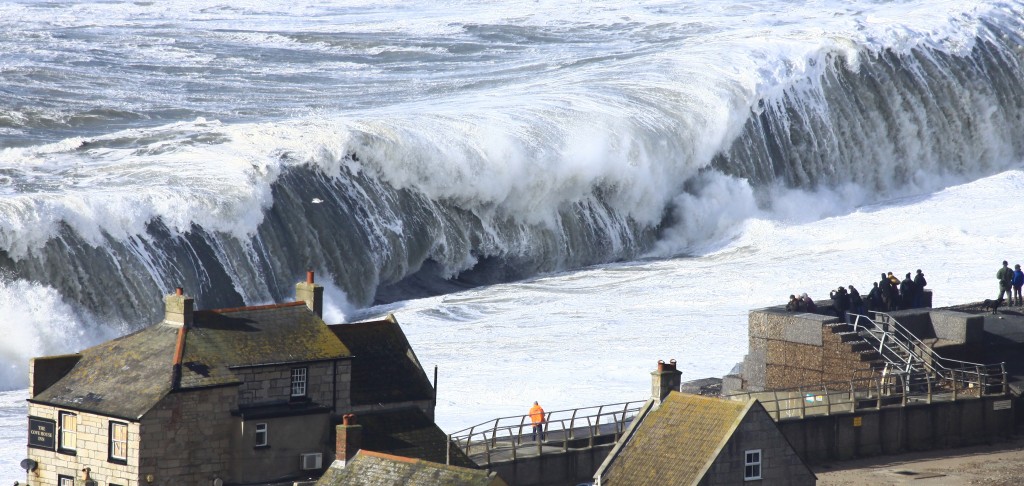16 March 2016
WASHINGTON, DC — The repeated storms that battered Europe’s Atlantic coastline during the winter of 2013/14 were the most energetic in almost seven decades, new research has shown.
They were part of a growing trend in stormy conditions which scientists say has the potential to dramatically change the equilibrium state of beaches along the western side of the continent, leading to permanent changes in beach gradient, coastal alignment and nearshore bar position.

The storms that battered Europe’s Atlantic coastline during the winter of 2013/14 were the most energetic in almost seven decades, according to new research. Some of these storms featured extreme waves, such as this one crashing on Chesil Beach in Dorset, southern England, on February 5, 2014.
Image credit: Richard Broome.
In a study published yesterday in Geophysical Research Letters, a journal of the American Geophysical Union, researchers compared modelled and measured data from sites across Scotland, Ireland, England, France, Portugal, Spain and Morocco and showed that the extreme weather conditions of 2013/14 were the most energetic since at least 1948.
The study showed that along exposed open-coast sites in the UK and France, there had been extensive beach and dune erosion due to offshore sediment transport, with sediment losses of up to 200 cubic meters (7000 cubic feet) for every 1-meter (3-foot) strip of beach. At some of the other sites, the balance between different alongshore sediment transport contributions was disrupted, causing changes in coastal alignment, referred to as beach rotation.
“We have previously conducted research showing the devastating effects caused to the UK by the stormy winter of 2013/14,” said Gerd Masselink, professor of coastal geomorphology at Plymouth University in the United Kingdom and the study’s lead author. “But the damage caused to coastal communities there was replicated – and in some cases exceeded – across western France. All but one of the sites assessed for this study reached their most depleted state at the end of the 2014 winter, and it will take many years for them to fully recover.”
For the study, researchers used a combination of modelled and measured wave data from the eastern Atlantic, stretching from Morocco to northwest Scotland, and also analyzed long-term beach profile data from sites in Ireland, UK and France.
The results showed that extreme wave conditions occurred up to five times more frequently in 2013/14, and winter wave heights were up to 40% higher, than on average.
“The extreme winter of 2013/14 is in line with historical trends in wave conditions and is also predicted to increasingly occur due to climate change according to some of the climate models, with the winter of 2015/16 also set to be among the stormiest of the past 70 years,” said Tim Scott, a lecturer in ocean exploration at Plymouth University and a co-author of the study. “Whether due to more intense and/or more frequent storms, it should undoubtedly be considered in future coastal and sea defense planning along the Atlantic coast of Europe.”
###
The American Geophysical Union is dedicated to advancing the Earth and space sciences for the benefit of humanity through its scholarly publications, conferences, and outreach programs. AGU is a not-for-profit, professional, scientific organization representing more than 60,000 members in 139 countries. Join the conversation on Facebook, Twitter, YouTube, and our other social media channels.
Notes for Journalists
This research article will be open access for 60 days from the date of publication. A PDF copy of the article can be downloaded at the following link: http://onlinelibrary.wiley.com/doi/10.1002/2015GL067492/pdf
After 60 days, journalists and public information officers (PIOs) of educational and scientific institutions who have registered with AGU can download a PDF copy of the article from the same link.
Journalists and PIOs who have not registered with AGU may order a copy of the final paper by emailing a request to Lauren Lipuma at [email protected].
Please provide your name, the name of your publication, and your phone number.
Neither the paper nor this press release is under embargo.
“Extreme wave activity during 2013/2014 winter and morphological impacts along the Atlantic coast of Europe”
Authors:
Gerd Masselink, Tim Scott: Coastal Processes Research Group, School of Marine Science and Engineering, Plymouth University, Plymouth, United Kingdom;
Bruno Castelle: Oceanic and Continental Environments and Paleoenvironments Mixed Research Unit, National Center for Scientific Research, University of Bordeaux, Pessac, France;
Guillaume Dodet, Serge Suanez: Littoral, Environment, Remote Sensing, Geomatics Mixed Research Unit, National Center for Scientific Research, European University Institute for the Sea, Plouzané, France;
Derek Jackson: Centre for Coastal and Marine Research, School of Geography and Environmental Sciences, Ulster University, Coleraine, United Kingdom;
France Floc’h: Oceanic Mixed Research Unit, National Center for Scientific Research, European University Institute for the Sea, Plouzané, France.
Contact Information for the Authors:
Gerd Masselink: [email protected]
Lauren Lipuma
+1 (202) 777-7396
[email protected]
Plymouth University Contact:
Alan Williams
+44 01752 588004
[email protected]